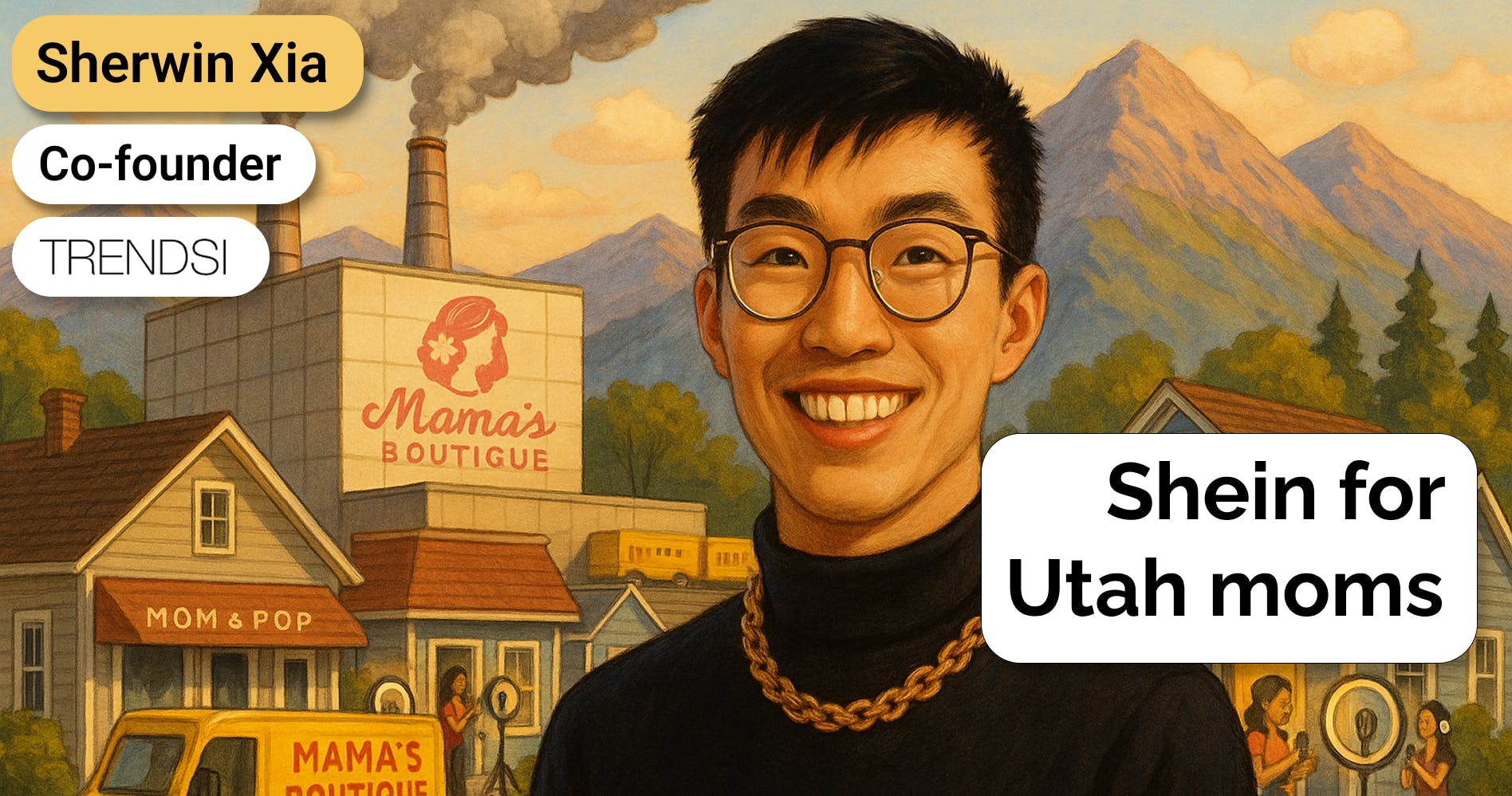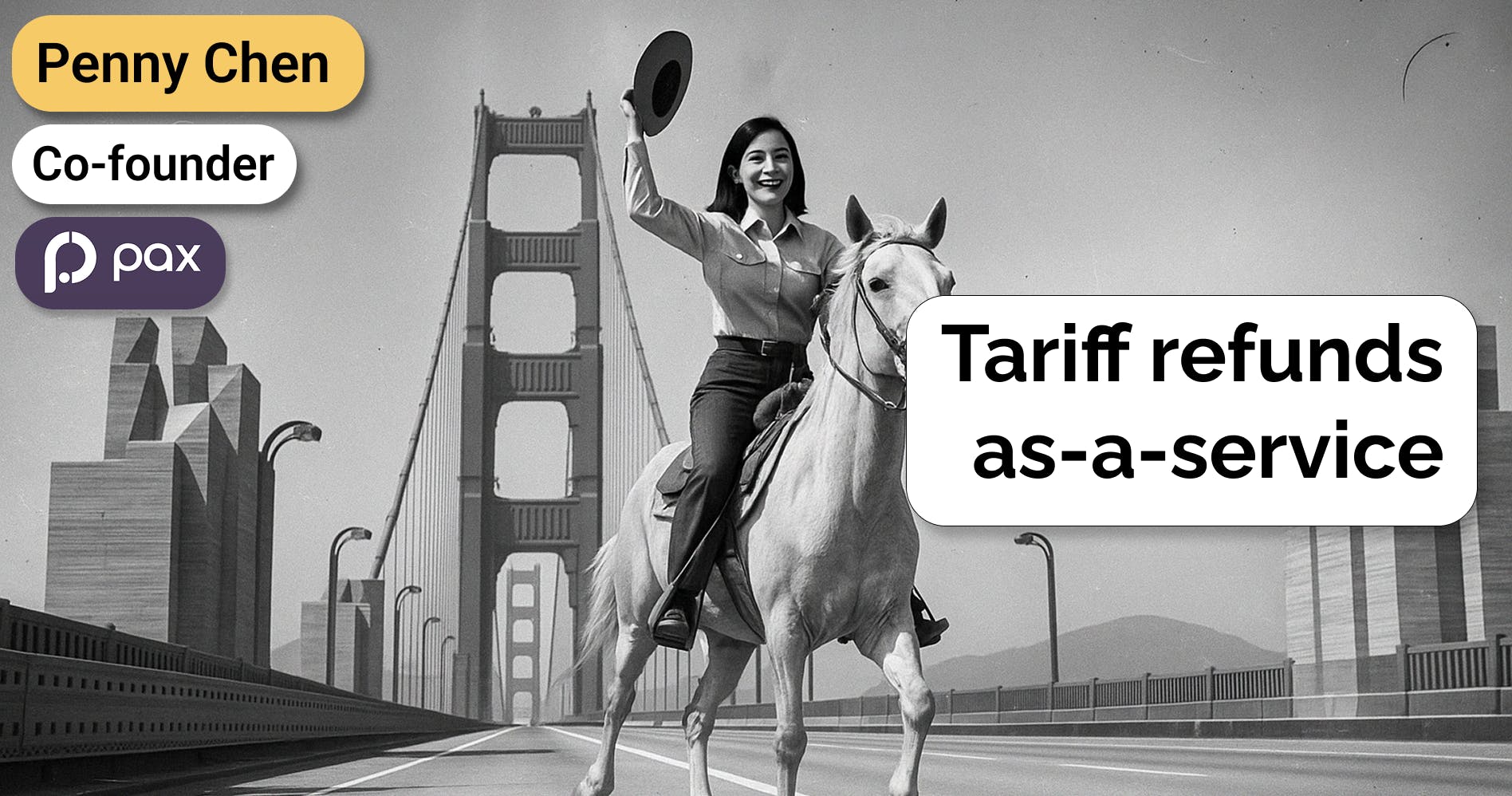Sherwin Xia, co-founder of Trendsi, on building the Shein for Utah moms
 Jan-Erik Asplund
Jan-Erik Asplund

Background
New tariffs on China-origin parcels and the likely rollback of the $800 de minimis loophole are squeezing the margins—and stretching the shipping times—of the cross-border dropshipping playbook that powered Shein, Temu, and thousands of Instagram and TikTok merchants and creators.
We reached out to Sherwin Xia, co-founder of Trendsi ($25 million Series A, Lightspeed), to learn more about how American SMBs are reshoring and rebuilding their supply chains.
Key points from our conversation via Sacra AI:
- The end of the de minimis exemption and new 10–20% tariffs on Chinese parcels have pushed Shein to ship best-selling SKUs in bulk to U.S. warehouses to avoid per-parcel duties, while selectively shifting lower-complexity manufacturing to Vietnam and Turkey to hedge against rising China-origin costs. "Everyone foresaw [de minimis] would eventually be canceled or paused, so companies have been preparing for a long time. The second aspect is the actual additional punitive tariffs, which people didn't forecast to come so quickly. For all these companies, not just Shein, they've been trying to diversify on two fronts. One is diversifying their supply chain... The other diversification effort is internationalization."
- Tariffs are breaking the dropshipping model—previously favored by creators and part-time sellers on TikTok and Whatnot—by wiping out margin and extending shipping times, leaving small merchants & creators with the now-even-more cost-intensive and logistically demanding task of buying inventory upfront, storing it at home, and handling fulfillment themselves. "If shipping exceeds 10-14 days, it's problematic because customers forget what they ordered, which hurts your brand image… We think the era of low-ticket value drop shipping from overseas might be ending. It still makes sense for high-ticket value items to be drop-shipped from overseas because even with tariffs, there's enough margin to cover the costs.”
- A new ecosystem of companies is emerging to enable a more resilient, diversified ecommerce model of 10% dropship, 30% proprietary designs, and 50% white-label products: TikTok Shop and Whatnot for discovery, supply-chain-as-a-service platforms like Trendsi for product testing, quality control, and fulfillment, and specialized manufacturers like Unmade and Unspun to help creators develop custom products in U.S. factories. "A typical successful fashion business we work with might only use drop shipping for 10-20% of their inventory, primarily to test new styles. About 50% might be wholesale with their own labels. The remaining 20-30% they design themselves—unique, proprietary products that help them stand out... we believe the future of commerce should be decentralized, where everyone can have a voice and more brands can emerge."
For more, check out this other research from our platform:
- Shein vs Trump
- Shein vs H&M vs Zara
- Penny Chen, CEO of Pax, on building AI-powered tariff refunds
- Whatnot at $359M/yr
- Sean Frank, CEO of Ridge, on the state of ecommerce post-COVID
- Faire at $616M/year growing 74%
- ShipBob: TikTok's $500M/year fulfillment arm
- Tyler Scriven, CEO of Saltbox, on co-warehousing and D2C ecommerce
- Shopify of India
- Fanatics at $8.1B
- Sampad Swain, CEO of Instamojo, on building ecommerce infrastructure for D2C 2.0
Questions
- How did Shein get started? How did it take off? And what did consumers really love about it?
- Given the context of 2025, with tariffs going up 130-145%, how does that affect their core business? In the most basic way, how do tariffs really affect Shein?
- With de minimis, would they continue to ship small shipments directly to the US?
- You mentioned other countries like Southeast Asia and Vietnam. But from what I understand, there are unique properties of Chinese manufacturing districts that made Shein possible—high density of different types of factories. Is that replicable? Can you do that in Ho Chi Minh City? Does that exist anywhere else?
- Let's talk about Trendsi. What got you started on the company in 2020? What made that a great time?
- How do you think about the difference between something like Oberlo, the Shopify plug-in that does drop shipping, and Alibaba, and Trendsi?
- When we look at the core customers of Trendsi, do they fit into the creator economy? Are these people also doing courses and selling digital products on Kajabi, Patreon, or other platforms? Are they multi-type creators?
- To bring it back to the macro stuff, how are Trendsi's customers affected by the recent round of tariffs? And what is Trendsi doing on the supply chain side going into the rest of 2025 and 2026?
- If everything goes well in the next five years for Trendsi, what does Trendsi look like and how is the world kind of different?
Interview
How did Shein get started? How did it take off? And what did consumers really love about it?
Shein started quite some time ago, about ten years ago. They started doing wedding dresses first, trying different means to sell to consumers. In the very early days, they tried to open their own Shopify store, following a typical ecommerce trajectory.
They really got a few things right in the later stage. They captured the emerging trend of using influencers to promote products on social media when influencer marketing was still pretty new, making their approach viral in the early days.
But that's just on the front end. On the back end, more interesting things were happening. Their most amazing strength is their ability to launch so many styles every single day. One interesting thing we learned from people at Shein is that they do so well in fashion because they don't know fashion. This means they use a data-driven approach.
Shein's approach centers on launching thousands of SKUs every day—sometimes up to 10,000. They launch many new styles at very small cost, allowing them to restock really fast and do very small batch production. Because they can restock quickly, they only manufacture a small batch in the beginning for each style. Within the same budget, they can launch many more styles because the budget for the first batch is quite small compared to other fast fashion companies where you typically have to order much more inventory upfront.
With all these new styles, they capture data from consumer buying behavior. Within one to three days, they can quickly analyze what elements are working within each style. It could be a ribbon, a fabric—they then do combinations like ribbons with different fabrics, or certain fabrics with different styles.
What's even more interesting is that initially they designed everything themselves, but to expand and launch more styles, they recruited manufacturers with design capabilities—what we call Original Design Manufacturers (ODMs). These manufacturers provide tons of designs, and Shein then gives direction saying, "These are the hottest trends and elements. Work on these designs." The manufacturers create designs for Shein's buyer team to pick from. Any style picked by Shein can be launched and generate significant sales, so every factory tries to get picked.
They've built an engine for designing many new styles, picking the right ones, and making it work. Many Shein products may not have original designs, but they've learned from launching a lot of styles and using that data to inform future designs, all done very quickly.
Given the context of 2025, with tariffs going up 130-145%, how does that affect their core business? In the most basic way, how do tariffs really affect Shein?
There are two things to consider about tariffs. First is the de minimis exemption—if your package is under $800 in value, you can import duty-free with no tax. Everyone foresaw this would eventually be canceled or paused, so companies have been preparing for a long time.
This exemption was actually one of the secret sauces for Shein and other cross-border companies to be so successful initially. They developed the impressive capability to ship millions of packages daily from overseas to the US at affordable prices with reliable 5-10 day delivery times. Many people overlooked this capability.
The second aspect is the actual additional punitive tariffs, which people didn't forecast to come so quickly. For all these companies, not just Shein, they've been trying to diversify on two fronts. One is diversifying their supply chain. Even though most manufacturing is currently in China, which is where they can restock so quickly, they're expanding to other markets like Southeast Asia, Vietnam, or Turkey.
The other diversification effort is internationalization—not focusing only on the US market but expanding to other countries, trying to increase revenue from places besides just the US.
The tariffs will impact their China-to-US business, but companies foresaw this coming a year or two ago. They've been ramping up local warehouses in the US and preparing for this, so the impact might not be as huge as we might think. The tariffs are expediting the process of companies diversifying their supply chains beyond just China.
With de minimis, would they continue to ship small shipments directly to the US?
They will still do that, but that business will probably decline in the long term. It doesn't make sense to ship small packages, especially low-ticket value items. We think the era of low-ticket value drop shipping from overseas might be ending.
It still makes sense for high-ticket value items to be drop-shipped from overseas because even with tariffs, there's enough margin to cover the costs. People will still want to do that, not just to the US but to other countries. From China to other countries, that business model will still exist, but to the US, it will continue to decline. We'll see how consumers react to the 10-20% price increases.
They'll also ship bulk shipments to US warehouses. But that's not just to avoid tariffs—even without tariffs, they were planning to do this anyway because they're trying to compete with Amazon and other local competitors. One of the biggest complaints about overseas shipping is the delivery time. To increase market share, they need local warehouses with two-day shipping. They're improving that part of their operation, as are all companies doing cross-border business, to improve shipping times.
You mentioned other countries like Southeast Asia and Vietnam. But from what I understand, there are unique properties of Chinese manufacturing districts that made Shein possible—high density of different types of factories. Is that replicable? Can you do that in Ho Chi Minh City? Does that exist anywhere else?
Based on my knowledge, at this moment, not really. The ability to restock and reproduce within seven days, which is how Shein operates, exists only in China currently. Could other countries do it in the future? Maybe yes, but it will take time.
The density of the manufacturing chain—from raw yarn to dying, fabric, sewing—everything is within a small area for women's apparel in Guangzhou, for example. If something goes wrong, they can quickly go to another factory to get it fixed, making the turnover time very quick.
I know Shein has been trying to establish this in Vietnam as well. However, if you send fabric to Vietnam and they find an issue with it, like problems with the dye, they might have to send it back to China to be redyed, which takes forever. Not having everything in one place is the issue preventing such fast turnaround times.
This applies to all supply chains, not just fashion. China's advantage is the density of all these facilities in one place, allowing them to move quickly. Other countries might be able to do it in the long run if they invest in all the different components of manufacturing.
Let's talk about Trendsi. What got you started on the company in 2020? What made that a great time?
We started in late 2020, in the middle of COVID. My previous background was at Lime, the e-scooter sharing company—a very operations-heavy, low-margin business, similar to Trendsi and ecommerce.
During COVID, Lime was hit hard because it's in transportation. We had a downsized round with Uber, and the founders and early team members all left at the same time. We were trying to figure out what to do next.
As someone originally from China with a background in both the US and China, we were looking for aspects of Asian culture or business models that we could localize in the US and Europe. The entire Lime idea was like that—bike sharing was very popular in Asia and Singapore, and we tried to localize it here. The manual pedal bike didn't work at first due to cultural differences—Americans don't bike to commute as much and everyone has cars. But we pivoted to scooter sharing, which worked much better.
When starting Trendsi, we wanted to find an industry that was booming long-term and could also be expedited by COVID. Ecommerce was definitely one. In terms of ecommerce—the different ways to buy things—the East is ahead of the West with things like live streaming. We felt the US had a lot to catch up on, and COVID boosted ecommerce significantly.
We also considered remote working and virtual reality, as Oculus had just released their Quest. But we ultimately picked ecommerce because we felt that as a cross-border team, we could excel by adapting what was working well overseas in Asia.
We had been observing what was happening in Asia and saw many small merchants operating on WeChat in China. These might be everyday moms who know people in their neighborhood and act as opinion leaders, selling to their "private traffic"—people they actually know in real life. This is huge in China, and there are many businesses providing supply to these small merchants.
This made us wonder if a similar ecosystem existed in the US. Are there small and medium merchants who are farther from the supply chain, looking for supply chain solutions? That's how we got started—by identifying a business model that was already working well in Asia, called S2B2C (supplier to business to consumer), where a platform provides supply to brands, individual influencers, or small businesses.
We researched the US market and found a very similar demographic to what we saw in Asia—mostly stay-at-home moms, aged 25-45, living in smaller cities rather than major urban centers. Many had local brick-and-mortar boutiques or had worked for multilevel marketing companies like Mary Kay or Young Living.
We found many of these people in Utah, where there's a strong sales culture. The multilevel marketing companies had taught these people great sales tactics, so we had a huge crowd of individuals who were good at sales but wanted to sell fashion rather than essential oils or water filters—they wanted to run their own businesses.
We investigated how they were getting their products. To our surprise, many of these stay-at-home moms or small business owners would drive to LA's fashion district to buy wholesale, load up their trucks, drive back to their states, store the goods in their basements, and then pack and ship orders themselves. This was shocking to us because nobody in China or Asia does that—it's always drop-shipped. In China, drop shipping is taken for granted; nobody stores products in their homes and ships themselves.
We saw this as an opportunity to help these sellers connect with suppliers in Asia and the US, and facilitate drop shipping. These sellers faced huge upfront barriers to starting their businesses because they had to buy a lot of inventory. Fashion is particularly challenging because each item has many sizes and colors, resulting in numerous SKUs. If you want to stock all these variations, that's a lot of money. Since these sellers were small operations, even with inventory, they lacked the capacity to package and ship to customers efficiently. They were stuck at 50-100 orders per day.
We identified this pain point and proposed to handle drop shipping for them. Though we didn't initially choose fashion because it's the hardest industry, our customers—the sellers we worked with—really wanted to sell fashion. We worked backward from their needs and started with fashion, later expanding to jewelry, home goods, and other categories that these people could influence.
How do you think about the difference between something like Oberlo, the Shopify plug-in that does drop shipping, and Alibaba, and Trendsi?
The biggest difference is that while they all claim to be drop shipping companies, the reality is very different. Oberlo and similar companies are just software companies, while Trendsi is a supply chain company. We're using tech to automate processes, but we're fundamentally a supply chain company.
A software company like Oberlo is just a connector—they connect you with suppliers that you have to pick from and work with individually. You have to manage everything yourself. The biggest issue with drop shipping, as we learned from our user interviews, is that it's really hard to manage when you have many different suppliers. You have to vet each one, and their shipping reliability varies greatly. Some ship fast, some ship slowly, and as a brand, if your shipping times are inconsistent, it's hard to maintain a consistent brand experience.
When you work with many suppliers who each ship individual packages, your shipping costs also become enormous. You need someone to combine packages and make them feel like they're coming from your brand.
From the beginning, we wanted to do drop shipping right. Many people hate drop shipping because it's unreliable, but we knew it could be reliable because that's how it works in Asia—everyone uses it and loves it there. The key is building your own infrastructure. We have our own warehouse and systems so that even though we work with many manufacturers and suppliers behind the scenes, we handle quality control and shipping ourselves. This gives customers a consistent drop shipping experience with fast shipping and the ability to add their own branding.
The biggest complaint about drop shipping isn't bad software—it's poor product quality and slow shipping. That's the core problem we needed to solve. People come to you because your products are unique or lower-priced than others and ship reliably. Even if your front-end looks bad, they'll still use your service if you solve these core issues.
That's why we built everything in-house. Trendsi is an operationally heavy, low-margin business, similar to Lime, Uber, or DoorDash. But that operational complexity is also a moat because others don't want to do it. We're not afraid of copycats because unlike a software company where you can spin up code in two weeks, you have to spend a year or two building this entire infrastructure from the ground up. There's no shortcut.
When we look at the core customers of Trendsi, do they fit into the creator economy? Are these people also doing courses and selling digital products on Kajabi, Patreon, or other platforms? Are they multi-type creators?
Now, after four years, we have both types of customers. But in the beginning, there was a clear distinction between influencers and the stay-at-home moms. The Utah moms are really good salespeople, and many weren't yet influencers but desperately wanted to become influencers. For some, selling is their job—they might be sales representatives at department stores. Their livelihood depends on selling.
Influencers and creators, on the other hand, typically don't come from sales backgrounds. They might be photographers or something else. To them, selling or ecommerce is just merchandise—a side thing. They're cautious about posting too frequently on their profiles to avoid diluting their content, and they care deeply about their following. They also have very high standards when working with brands because they want to ensure their products are the best.
For a startup, it's initially difficult to work with influencers. They have higher standards that require a stronger supply chain and excellent service, which is challenging to fulfill when you're just starting. Some might also drop off in the middle of a partnership because it's not as important to them as it is to the stay-at-home moms.
In the beginning, we focused our efforts on acquiring the stay-at-home mom profile and helping them become influencers. Now, many of them have become more popular on TikTok. As TikTok Shop and Whatnot grew, we started working with these platforms, encouraging our customers to use them to get more traffic.
This parallels the situation in China, where the top live streamers often have backgrounds in sales, like former department store representatives who excelled at sales and then became famous. There are also celebrities who do live streaming for fun. Both can generate traffic and GMV (Gross Merchandise Value), but for consistent GMV and dedication to their business, the sales professionals usually perform best. The celebrities tend to do it as one-off events.
So now we have a broader demographic—both influencers and these sales-focused moms. In the beginning, we focused on the moms, and that has worked well for us.
To bring it back to the macro stuff, how are Trendsi's customers affected by the recent round of tariffs? And what is Trendsi doing on the supply chain side going into the rest of 2025 and 2026?
People often think of us as a drop shipping company because that's one of our primary services, but we're a supply chain company. Long-term, we want to help anyone quickly grow and start their fashion brand. Drop shipping is just the tip of the iceberg—it's the easiest way for someone to get started.
The drop shipping business model has limitations. It's great because there's low upfront cost for sellers since they don't need inventory. However, their margin may be lower because we handle fulfillment. The other major issue with scaling drop shipping is inventory. No one in ecommerce can escape inventory. When you grow to a certain size, you need stability in your inventory. With drop shipping, everyone shares the same inventory pool. You might spend $20,000 on Facebook ads, and seconds after launching, your inventory could be claimed by someone else, leaving you out of stock.
You see a spectrum in the industry. Drop shipping offers 0% inventory cost but very low certainty on inventory availability and no control over inventory stability. Wholesale requires 100% upfront payment, but gives you 100% control. We believe there should be a middle ground—maybe you pay 30% upfront cost for 70% inventory control. As you scale in ecommerce, especially for fashion brands, the 80/20 rule applies—20% of your hot-selling SKUs generate 80% of your GMV. You want to ensure those 20% are always in stock.
Also, to elevate your brand, you want to develop your own line with your logo, sewing labels, and packaging. You want branded products that differentiate you from everyone else.
At Trendsi, our product offering starts with drop shipping, which is great for quickly testing trends and figuring out what works for your audience. Once you identify what works, we recommend stocking up on inventory for your best-selling products. We even offer made-to-order manufacturing where we can put your logo on products to create your own line. This lowers your cost and builds your brand—it's not just drop shipping off-the-shelf products.
A typical successful fashion business we work with might only use drop shipping for 10-20% of their inventory, primarily to test new styles. About 50% might be wholesale—off-the-shelf products with their own labels. The remaining 20-30% they design themselves—unique, proprietary products that help them stand out. To be successful, a brand needs to differentiate with products manufactured exclusively for them.
Now, regarding tariffs, since many of our products ship from overseas, they will definitely be impacted. Both product costs and shipping times might increase. We're actually more concerned about shipping times than prices. Currently, overseas shipping takes about 10 days, which is already at the edge of what's acceptable.
When we tested what shipping time is still acceptable, we found that people say "if I receive a package that I forgot I ordered, that's too long"—and that happens at around two weeks. If shipping exceeds 10-14 days, it's problematic because customers forget what they ordered, which hurts your brand image.
So while we can keep prices relatively stable even with de minimis gone, we worry about extended shipping times due to additional customs steps. This could have a larger impact. We expect the drop shipping segment to decline for US customers. We're encouraging our customers to work with US vendors and non-Chinese vendors that aren't affected by tariffs.
For our overall business, since drop shipping is just one part of it—primarily for testing products—the decline in overseas drop shipping efficiency won't be devastating. The bulk of our revenue and margin still comes from bulk order manufacturing.
If everything goes well in the next five years for Trendsi, what does Trendsi look like and how is the world kind of different?
I envision Trendsi as a B2B version of Shein. We're building similar transportation and supply chain capabilities as Shein, but instead of designing everything ourselves and selling directly to consumers, we're putting that capability into the hands of individuals and brands in the US.
It's really hard for small brands to compete with larger marketplaces and brands. We believe the future of commerce should be decentralized, where everyone can have a voice and more brands can emerge. We want to lower the barrier to entry for anyone starting their own brand. We aim to be the supply chain infrastructure for new and small brands, helping them grow.
Hopefully, in the long term, we can even incubate and invest in some brands. In five years, I hope there will be many well-known brands that started on Trendsi—we helped them get there from the beginning.
Trendsi won't be limited to just fashion. Fashion is hard, but if we can succeed with fashion, we can easily expand to other categories like jewelry and home goods. We can become the backbone for many new small and medium brands and businesses on the supply chain side, allowing them to focus on what they're really good at: marketing, sales, branding, and design. We'll handle the heavy lifting.
Disclaimers
This transcript is for information purposes only and does not constitute advice of any type or trade recommendation and should not form the basis of any investment decision. Sacra accepts no liability for the transcript or for any errors, omissions or inaccuracies in respect of it. The views of the experts expressed in the transcript are those of the experts and they are not endorsed by, nor do they represent the opinion of Sacra. Sacra reserves all copyright, intellectual property rights in the transcript. Any modification, copying, displaying, distributing, transmitting, publishing, licensing, creating derivative works from, or selling any transcript is strictly prohibited.







